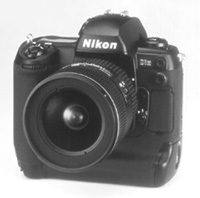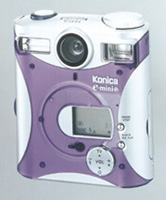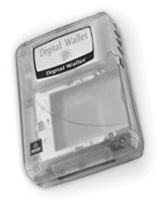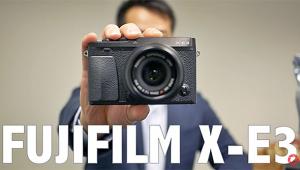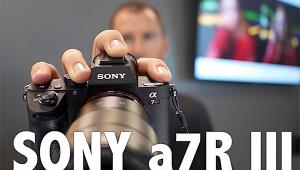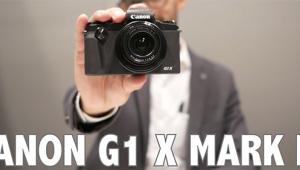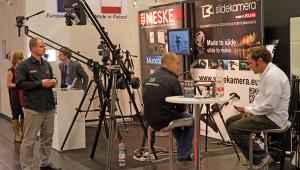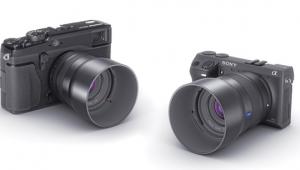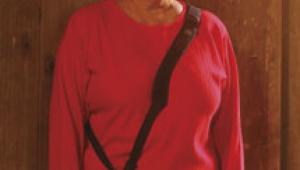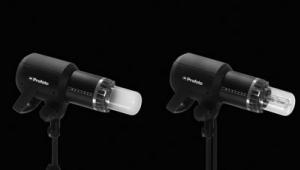Digital Imaging At The Begining Of The 21st Century
"The software stopped
working when I upgraded from Windows 92 to Windows 95." It's interesting that the only camera appearing in the film 2001: A Space Odyssey plays a pivotal role in story development. In the "Tyco crater" sequence, when astronauts pose for a picture in front of the black monolith, the photographer's flash appears to trigger the blast of sound that ultimately directs the expedition of Dave, Brad, and Hal toward Jupiter's moons. While neither Hal nor Dave was in attendance at Orlando's PMA 2001 show, there were lots of new sights and sounds that would have sounded like fiction not so long ago. At the aptly named Applied Science Fiction booth, I watched my photograph digitally appear on the front panel of a process-it-yourself kiosk within six minutes of having film placed into it. At Silicon Film's booth, I loaded their EF-1 digital cartridge into a standard issue Nikon N90s and made digital photographs and saw this long-awaited technology become a reality. The rest of the show was filled with evolutionary digital products and services that continue the march toward increased use of digital technology in the photographic process. But there are signs that the "them vs. us" mentality is disappearing. Digital detente was achieved when the Digital Imaging Group (DIG) and Photographic Imaging Manufacturers Association (PIMA) announced their intention to merge, proving that, to paraphrase Billy Joel, it doesn't matter how you capture or print an image, it's still photography to me. Image Capture: Digicams High on the list of coolness was actually seeing Silicon Film's Electronic Film System in operation and having a chance to drop their CMOS-based (e)film cartridge into a Nikon N90s and make a digital image with it. The system includes the (e)film cartridge, (e)port carrier, and (e)box storage module that lets you transfer captured images to a Mac OS or Windows computer. The (e)film cartridge is currently designed for the Nikon F5, N90, F3, and Canon EOS 1N and A2. At the show, I transferred eight 2.7MB TIFF files onto a 20MB Com-pactFlash card that I borrowed from eDigitalPhoto.com contributor John Stewart. Since 2.7MB won't be enough for some pixel pushers, Silicon Film wisely bundles Genuine Fractals 2.0 LE software to enable them to capture 1.3 megapixel images and print them in larger formats than might otherwise be possible. Cool And Small Digital SLRs |
|
Digital Siblings Canon's new Digital Elph, the PowerShot S300, is just a smidge bigger than the original. Wrapped up in a svelte stainless steel body, the camera has a 35-105mm (equivalent) 3x zoom lens and captures 2.1 megapixel images at 1600x1200 resolution. This new Digital Elph accepts Type I CompactFlash cards and is bundled with an 8MB card. The new PowerShot A10 and A20 are twins. The A10 has a 1.3 megapixel imager, while its big brother the A2 packs 2.1 megapixels onto its CCD chip. Both are equipped with a 35-105mm (35mm equivalent) zoom lens and powered by four--count 'em--AA batteries. Price of the A20 is $599, while the A10 costs $499. The A10 is available in a kit that includes Canon's new portable printer (more on that later in this story) for $699. |
|
Play That Funky Music Vivitar's stylish ViviCam 2795 is a digital camera and MP3 music player, which can also capture audio and video clips. The under $200 camera uses a CMOS sensor to trap 640x480 images and store them on 2MB of built-in memory. A 16MB Com-pactFlash card is optional. The $399.95 ViviCam 3655 is a 2.3 megapixel camera with a 4.6x zoom with a 35mm equivalent focal length range of 38-90mm. The 3655 supports CompactFlash cards and a 8MB card can store a maximum of 29 economy mode photographs. The big digicam news from Vivitar is the Hybrid DIGI 35mm that can capture images on film or digitally. The camera has two lenses: a 33mm f/4 lens for 35mm film and a 4.4mm f/3.5 lens for the camera's CMOS imaging sensor. The camera simultaneously captures each photograph digitally into internal memory, which can be deleted or later downloaded to any Windows-based computer. |
|
Konica's striking new e-mini M digicam with MP3 capability is so cool looking that there was already a knockoff of the design on display at the show. Weighing less than 5 oz, without batteries, the camera can capture images in two formats, includes an audio recorder function, and has both NTSC and PAL video output. Polaroid, who is not one to miss or start a trend, has a new 640x480 PhotoMAX MPS digital camera that lets you listen to tunes and make images. For $249.95, the Windows-only combo digicam decked out in iMac blue comes with a 16MB CompactFlash card and a set of headphones. Polaroid's new under $400 PhotoMAX PDC 2300Z has 2.3 megapixel resolution and a 2.3x optical zoom. Capturing images at 1816x1208, the camera has a 1.8" LCD panel, and bundles a 8MB CompactFlash card for image storage. Proving that combo digicams can have something besides an MP3 player, Polaroid's other new camera is the PhotoMAX PDC 640 Modem Camera, a 640x480 camera with built-in 56K modem. When connected to a standard phone jack, the PDC 640 uploads images for the PolaroidDigital.com web site for sharing with friends and family. From there, photographs can be sent to Polaroid's Digital Picture Frame. Samsung got into the act with the Digimax 35MP3 that also includes a pair of those cool, back-of-the-noggin' headphones. For under $300, the iMac-styled camera captures 640x480 images onto the bundled 8MB CompactFlash cards. The Digimax 35MP3 can also be used as a webcam and includes a cool tripod stand for stacking atop your Windows computer monitor. Non-music fans might prefer the Digimax 210 SE, a 2.1 megapixel with 3x optical zoom with a suggested retail priced under $1000. This one captures images up to 1600x1200 as well as moving JPEGs. It's compatible with both Mac OS and Windows computers and has both serial and USB connections. |
|
Pixel Count's Magic Number At PMA, 3 megapixels seemed to be the "magic number" for digicams--another trend?--with Tosh-iba's new $699 PDR-M65 camera that's capable of capturing 2048x 1526 JPEG images on a bundled 8MB SmartMedia card. The company's PDR-M61 model offers 2.3 megapixels with resolutions up to 1792x1200 and an all-glass 3x zoom lens. This camera stickers at $499 and, like the other new Toshiba digicam, is USB capable with both Mac OS and Windows computers. Olympus, who originally coined the term "megapixel" and inadvertently started this whole pixel race, gave me a preview of their soon-to-be announced D-100 point-and-shoot camera. This 1.3 megapixel camera has a price tag of $299 and will be able to capture 1280x960 images. Their soon-to-be released C700 digicam will have 2 megapixel capture capability with a maximum image resolution of 1600x1200. It is claimed to be the smallest digital camera with a 10x zoom. Olympus also showed two digicams that were introduced at the Consumer Electronic Show, including the 3 megapixel C-3040 Zoom with fast f/1.8 aspheric zoom lens and their $699 C-2040 Zoom 2.1 megapixel digicam. They also let me get my hands around their DS-2000 digital voice recorder that uses SmartMedia cards instead of tape (see sidebar). Casio's 3.34 megapixel QV-3500EX digicam will capture images up to 2048x1536 and is available in two bundles: One offers the camera with a 16MB CompactFlash card, while the other includes a 340MB IBM Microdrive and sells for less than $900. One of the camera's unique features is the "Best Shot" function that lets you select from one of 28 scenes (beach, blue sky, twilight, etc.) and the camera automatically adjusts its setting for what's in front of you. Sounds like a snapshooter's dream. SiPix is a name that may be new to Shutterbug readers but their products are interesting, affordable, and innovative. Their SC-2100 digicam is a 2.1 megapixel camera that sells for $279 and can store its 1600x1200 images on the bundled 8MB CompactFlash card. Bargain hunters will love the $99 DualCam, which is a combination USB monitor-top video teleconferencing camera that captures 640x480 still images. It also has a three mode built-in flash. Both cameras are aimed at Windows computer users. Panasonic started shipping the two cool-looking 3.3 megapixel ipalm digital cameras that were introduced at photokina. The PV-DC3000-A and PV-DC3010 models use SD memory cards for image storage. What's more, the company is providing slots in their new DV camcorders that accept either MMC or SD memory cards. Agfa Consumer Imaging showed two ePhoto digital cameras--the CL20 and the CL34--that were introduced at photokina. The 1.3 megapixel ePhoto CL34 features an optical viewfinder and 1.8" LCD screen and has a CompactFlash slot for storage. Priced lower, the CL20 offers the same features as its sister camera, but without an LCD display. Its internal memory can hold up to four images at the highest resolution. Both ePhoto cameras offer USB connectivity for easy installation. |
|
Digicam Hardware Tiffen's new series of MegaPlus wide angle, telephoto, and close-up lenses for digital cameras are designed to screw into the filter threads on the front of the digicam's lens, but their designers also found ways and made lens mounts that allow them to attach them to camera's not designed to accept auxiliary lenses. The 37mm and 43mm aluminum barreled lenses will also accept camera filters, including circular polarizer and star filters. The MegaPlus family of lenses have a suggested list price range between $39.95 and $99.95. They are compatible with cameras made by Agfa, Casio, Epson, Fuji, HP, Kodak, Nikon, Olympus, Polaroid, Sony, and Toshiba. The prices of lens mounts vary from $9.95 to $24.95. |
|
Image Enhancement/Software Another example of digital dtente was the announcement that nik Multimedia is licensing its technology to Cokin Filters AS in order to create digital versions of Cokin's many interesting camera filters. The new Cokin digital filter products will be available as Adobe Photo-shop compatible plug-ins and will be offered in several different languages for both Mac OS and Windows computers. Cokin estimates the products will be available by the second quarter of 2001. ArcSoft is a company that makes great, yet inexpensive imaging software and has also been expanding their offerings for Mac OS users. Their new PaintingMontage is a program that lets you transform photographs into 3D montage posters as well as hobby projects. The latest version of Photo-Impression, Version 3.0, was introduced earlier at MacWorld Expo 2001 and they expect to be have their flagship product, PhotoStudio, available for Mac OS X during the summer of 2001. Ulead, which launched Version 4.0 of their PhotoExpress consumer image-editing application shortly before PMA started, offers a suite of iMira Server Tools that are designed to be installed on your web site's server--if that server is running on Windows NT 4.0 or Windows 2000. iMira Editing lets your site's visitors enhance their images by using their browser. iMira Greetings gives users the ability to create customized greeting cards. What really caught my attention was iMira Search that lets visitors scan databases of photographs based on the visual elements within each file, and iMira Album, which lets you add photo-sharing capabilities to your web site. Shutterbug contributor Rick Sammon and I paid a visit to LizardTech to see what the lizards had that was new. It turned out that they had free compression software, called MrSID Photo Solo, that lets you compress JPEG and TIFF files smaller and with less image quality loss than other compression methods. The free software and browser plug-in can be downloaded from www.lizardtech.com. |
|
Image Capture: Scanners Since scanners have been around longer both in real-world terms as well as Internet time, they are in an evolutionary phase that focuses on improvements in resolution, lower cost, and increased functionality, such as the ability to scan both film and prints. Canon's two new flat-bed scanners, for example, feature built-in film adapters. Offering USB connectivity, the two 48-bit scanners are compatible with both Mac OS and Windows computers and can scan film up to 4x5 as well as prints. The CanoScan D2400 UF offers 4800x2400dpi optical resolution, while the CanoScan D1230 UF has 2400x1200dpi resolution. Price tags are $499 and $299 respectively. Agfa Consumer Imaging's Duo-Scan f40 is the first of its new generation of TwinPlate flat-bed scanners. The 42-bit DuoScan scanner offers both FireWire and USB connectivity and provides separate beds for scanning film or prints. Agfa includes glass-free slide holders with the scanner to eliminate interference, such as those pesky Newton Rings. The DuoScan f40 has an optical resolution of 2400x1200 and a dynamic range of 3.0. The reflective scanning area is A4/legal with an 8x10" transparency scanning area. |
|
ANikon's Super Coolscan 8000 ED is a multi-format scanner that offers 4000dpi optical resolution and includes Applied Science Fiction's Digital ICE3 suite of enhancement technologies. With a dynamic range from 0 to 4.2, the $2695 scanner handles film from 16mm up to 6x9 medium format. Nikon's $1695 Super Coolscan 4000 ED offers similar optical density and resolution for scanning 35mm and Advanced Photo System (with an adapter) film and also offers ASF's Digital ICE3 suite. The company's Coolscan IV ED is designed to let photo enthusiasts scan 35mm and APS (with an adapter) film at 2900dpi and 36 bits. Even with its modest price of $895, the scanner has ASF's Digital ICE3 suite built-in. Calling the Minolta Vivid 300 personal 3D digitizer a scanner might be a reach but I don't know where else to put a device that takes a three-dimensional image and coverts it into 3D graphical form. Looking more like a suitcase with some holes in it than either a scanner or camera, the Vivid 300 captures an image--or even multiple images that it can stitch together--to create solid 3D graphics that can be used to create sculptures or whatever else can be imaged from the mind of Minolta. Right now, Mac users are out of luck; the software only runs on Windows NT or Silicon Graphics systems. Image Output With Epson's introduction of their 2880dpi consumer and business ink jet printers, I knew that photo printers would be next and was pleased to see several new products at PMA. The three amigos include the Epson Stylus Photo 780, 890, and 1280 ink jet printers that deliver not only higher resolution but also borderless printing capability. All three offer six-color 2880x720 output quality with a four-picoliter droplet size. At $149 (after a $50 rebate) the Stylus Photo 780 may be the lowest priced photo quality six-color ink jet printer anybody has offered. The 890 and 1280 models include a new roll paper accessory that lets users print multiple 4x6" snapshots on 4" rolls. The $299 Stylus Photo 890 has the ability to handle rolls of paper and 44" long panoramic paper as well as heavy paper stock, such as some of those mentioned later in this report. The Stylus Photo 1280 has a 13" carriage and can print borderless 11x14 and 13x44 panoramas. This printer has a price of $499, identical to the spectacular Stylus Photo 1270. Epson's new Stylus Pro 5500 graphic arts printer has 2880x720 output in the 13" wide format. Concurrently with the new product's launch, the company cut the prices of their 5000, 9000, and 9500 models to $2495, $6995, and $7995 respectively. Epson's new PhotoCenter web site (www.photo.epson.com) is a free online photo-sharing site powered by PhotoPoint, which also allows visitors to do online printing onto traditional silver-halide papers. Cone Editions Press' new Piezography BW Pro24 is a digital printmaking system that produces high quality monochrome prints using an Epson 7000 printer. The system includes software and archival, carbon black pigment-based inks in six densities that replace the standard Epson software and inks. Jon Cone showed me monochrome prints made using his Piezography kit that works with inexpensive Epson desktop printers that rival those made on expensive IRIS printers. |
|
Canon's six-color S800 Bubble Jet ink jet printer is bundled with a CompactFlash card reader and offers 2400x1200 output resolution and four-picoliter droplet size. When printed on Canon's Photo Paper Pro the prints are said to have a 25-28 year fade resistant life. The printer is available for both Mac OS and Windows computers and has a street price of $299. Another potential trend at PMA was compact, portable printers small enough to fit inside a camera bag. You don't even need a computer to make prints with Canon's CP-10 dye sublimation printer. The printer can output wallet-sized (3.4x2.1") images directly from any compatible camera, such as the PowerShot S300, A20, and A10, in less than 1 minute. Canon's Chuck Westfall made a snapshot of me and I watched it being printed. The output quality was spectacular. Another camera bag-sized printer--this surely makes it a trend--is SiPix's $149 thermal technology Pocket Pinter. It produces 400dpi images using wireless infrared connectivity. It can also be connected to a Windows computer's serial port. Polaroid introduced their P-500 Digital Photo Printer that produces snapshot-sized Polaroid 500 instant color prints from SmartMedia or CompactFlash cards in 20 sec without a computer. The price for this portable printer is $249. Digital travel photographers will find it an easy way to make friends. Paper To Ink |
|
Van Son introduced a kit that includes one each of their EasyPrint color and black ink sets and 20 sheets of Olmec High Gloss ink jet paper from ICI Imagedata. ISO studies of their dye-based inks showed that the Van Son products are 10 times higher in light resistance than standard inks. EasyPrint cartridges are available for many Epson desktop printers including the 400, 500, 600, 700, 800, as well as Stylus Photo and Photo EX. Kodak now offers three new ink jet papers as well as a free download of their Picture Page software. The new papers include Ultima Picture paper, High Gloss, and Ultima Picture paper, Satin. Images printed on Ultima Picture paper using current Epson and HP printers should last 20-25 years, while prints made on the paper using Kodak's Picture Maker 200 ink jet printer will last more than 30 years. Picture Page software has an interface that offers a simple, one-step setup for printing on Kodak paper and is designed for Windows computers only. |
|
Hahnemhle, who I first encountered at last year's Seybold show, is getting into consumer ink jet papers in a bigger way. Having made paper since 1584, they should know a thing or two about making the stuff. They now offer 15-sheet pads of seven different kinds of ink jet papers, including Photo Art in card, gloss, and matte surfaces as well as Coarse Felt, Heavy Parchment, Rice Paper, and Soft Felt papers. At photokina, Ferrania announced they would be offering ink jet printing paper, and at PMA they showed the full line of available products including OptiJet Pre-mium Photo Paper, Artists Cotton Canvas, Photo Resolution Coated Paper, Adhesive Picture Paper, and Professional Imaging film. All of the OptiJet media is available in cut sheets and wide format rolls. Legion Paper, whose initial offering of consumer ink jet papers I praised in previous "Digital Innovations" columns, offers three new fine art ink jet papers. Their Somerset Photo Enhanced 100 percent cotton-fiber paper is available in both textured and velvet finish. Their Concorde Rag is another 100 percent cotton-fiber paper and has a vellum texture. The Canvas has a medium to heavy texture and is actually real canvas with a cotton blend and a photo enhanced coating. To promote the papers to photographers not familiar with Legion's products, the company will be offering giveaway packs with blank sheets of paper plus printed samples in black and white and color. |
|
Konica's new instant drying, water-resistant ink jet papers, known as Konica Photographic Ink Jet Paper QP, now include Professional Photo Glossy, Professional Photo Two-sided Photo Glossy, Premium Photo Self Adhesive, and Multi-Project Photo paper. Tetenal, who has won one of the categories in the ink jet paper shoot-out at PMA for two years in a row, has three new papers--Portrait Pearl Luster, Canvas Textile, and Aquarell--which were shown at photokina 2000. They are now available in the U.S.A. While at photokina, an artist asked me about handcoloring ink jet papers, and I've been looking for suitable material for her. Well, along comes Marshall's--who else?--with a kit that bundles their new ink jet canvas, an eraser, five tubes of transparent oils, a paintbrush, and 10 artist applicators. The oils may also be used alone in combination with other products that are part of Marshall's Photo Coloring System. |
|
Digital Tools And Accessories Since you can never have too much memory--in your computer or digicam--Minds@Work's Digital Wallet looks like a must-have accessory. The wallet is a PDA-sized device that lets you download images directly from your digital film media, including CompactFlash, SmartMedia Memory Stick, Microdrive, and MMC (via a PC-card adapter) onto the Wallet's 6GB hard disk. The process is a slam dunk and takes only a few seconds. Then you can stick the memory card back into your camera, wipe it clean, and then fill it up with new digital photographs. Images stored on the Digital Wallet can be transferred to your Mac OS or Window computer via its USB port. One of the cards you can use in the Digital Wallet is Delkin Device's new 128MB SmartMedia card. In case you weren't counting, 48 percent of the currently available digital cameras support SmartMedia and having more image storage capacity is always better than having less. After introducing its new Peerless Drive system at CES, Iomega announced they'll also be marketing CompactFlash cards in capacities from 16-128MB and SmartMedia cards from 16-64MB. Kingston Technology now offers a 256MB CompactFlash card for those digital photographers who never have enough space to capture "that next image." Continuing the PMA sub-trend of migration to SD and MMC cards, they also have a 32MB MultiMedia card at a suggested retail price of $75. Need more space? SanDisk has a 512MB CompactFlash card for $599. Over in the MMC column, Microtech, now part of SCM Microsystems, will be offering MultiMediaCards in 16MB and 32MB capacities and expect to have a 64MB card in the second quarter. |
|
Virtual reality images with any digital camera for less than $70? Virtual Showcase from VR Interactive, Inc. offers a bizarre looking but simple-to-use device that lets you shoot panoramic images that you can navigate though using Apple Computer's QuickTime technology. As you can tell from the real (no kidding) quotes overheard at PMA 2001, we still have a long way to go before everyone embraces digital imaging technology the way that some of us have. Nevertheless, this looks like it's going to be an interesting century, no matter what kind of imaging tools you use. As Al Jolson said in The Jazz Singer, "You ain't seen nothin' yet." |
